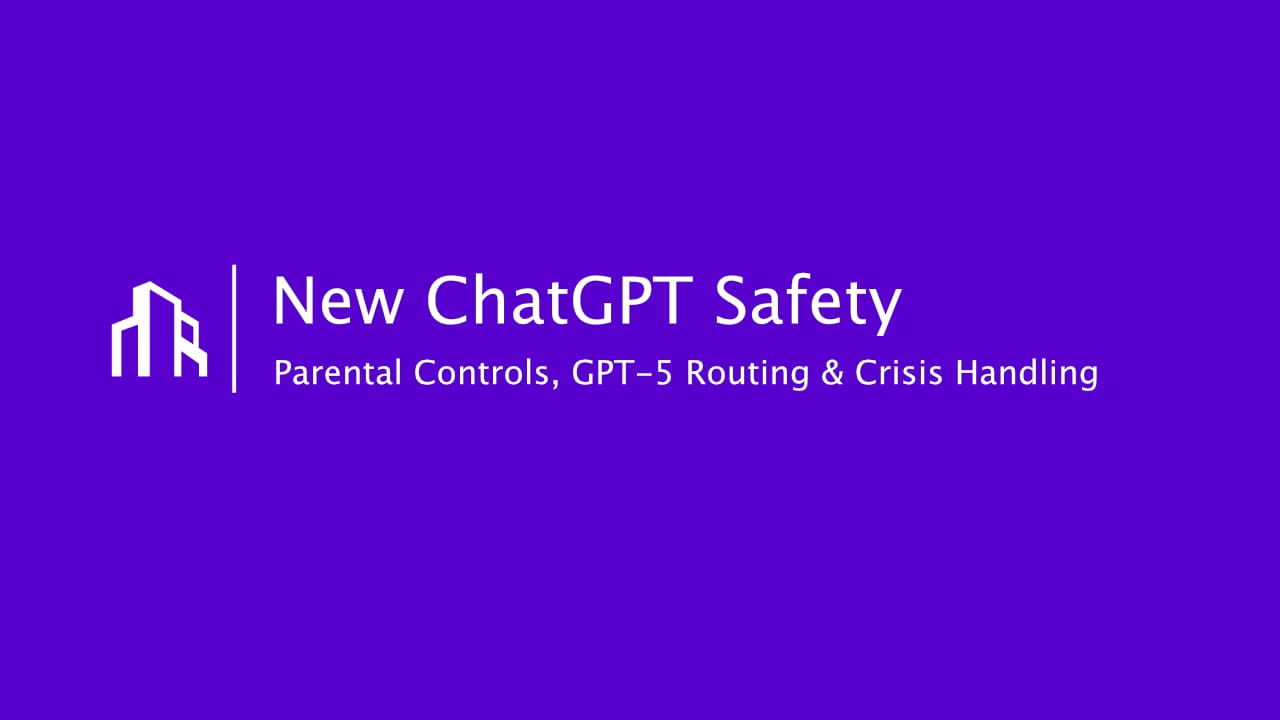New ChatGPT Safety: Parental Controls, GPT-5 Routing & Crisis Handling

Quick take
OpenAI is adding Parental Controls, routing sensitive chats to GPT-5, and distress-aware handling. For businesses, this raises the bar on governance, auditability, and disclaimers. Configure guardrails now; treat crisis flows as safety-critical.
What’s new (at a glance)
- Parental Controls → link a parent account to a teen’s and receive alerts for signs of acute distress. AP News The Guardian
- Sensitive chats → GPT-5 → OpenAI plans to route crisis-adjacent prompts to higher-reliability models. TechCrunch OpenAI
- “Safe completions” training → output-centric safety to avoid harmful replies while staying helpful. OpenAI
- Teen safeguards → tighter responses on self-harm, suicide, disordered eating; resource guidance. Engadget
- Transparency track → system cards + Safety Evaluations Hub and joint eval with Anthropic. OpenAI
Why this matters now
- Regulatory & legal pressure is rising; companies are expected to prove responsible deployment of AI assistants, especially where users disclose distress. These controls are a new industry baseline.
- Risk posture shifts from “refuse on bad prompts” to continuous detection and escalation. That means your policies, logs, and incident playbooks must adapt.
What changes for teams using ChatGPT at work
- Disclaimers & scope → add explicit non-clinical and escalation language wherever staff or customers can chat.
- Crisis SOP → define when to stop the bot, surface resources, and handover to a human fast (minutes, not hours).
- Guardrails → cap actions that write or notify third parties without approval; enable approval gates for sensitive workflows.
- Logs → record what was asked, what the agent suggested, who approved, and the final action. Keep PII minimal; set TTLs.
- Parental Controls (if relevant) → for education/non-profit youth programs, prepare parent links and consent templates.
- Model routing → adopt the principle: routine prompts → standard model; crisis-adjacent → GPT-5 (safer defaults).
Implementation checklist (copy/paste into your runbook)
- [ ] Place crisis disclaimers and resource links near every chat entry box.
- [ ] Create a keyword+classifier layer to spot distress patterns (self-harm, harm to others, eating disorders).
- [ ] On detection: switch to “safe completions” mode, reduce creativity, and route to GPT-5 where supported.
- [ ] Respond with empathetic, non-directive language and immediate resource pointers; avoid prescriptive advice.
- [ ] Trigger human-on-call; log event with minimal PII, mark as safety-critical.
- [ ] Add rate limits and cool-downs to prevent looping on distress topics.
- [ ] Review logs weekly: false positives/negatives, average time to human handover, closure quality.
Open questions to track
- False positives (over-flagging normal venting) vs false negatives (missed crises).
- Memory → how do parental controls and crisis flags interact with chat history/memory? Set defaults conservatively. The Guardian
- Data sharing → clarify who sees alerts and whether third-party tooling receives crisis markers.
- Jurisdiction → align with EU privacy norms if you operate in the EEA; default to data minimization.
What to monitor (weekly)
- Detection accuracy → precision/recall on flagged messages.
- Time-to-human → minutes from detection to human contact.
- Outcome quality → did the user receive appropriate resources and a follow-up?
- Audit trail completeness → message, model, mode, responder, outcome.
How Scalevise can help
- Policy & prompts → write crisis-aware prompts and response templates that stay inside compliance boundaries.
- Routing & guardrails → implement model routing and approval gates for risky actions.
- Audit-ready logging → set up min-PII logs with short TTL and export to your warehouse.
- Readiness tests → red team your flows with synthetic crisis cases before go-live.
Related reads on Scalevise:
